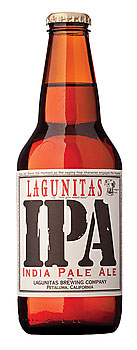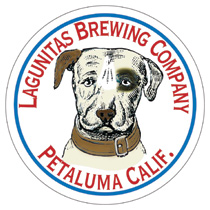
Zygotes. Elephants. Balloons. Wait. What were we talking about? Ah, yes. Lagunitas.
Tony Magee, founder and CEO of the 21-year-old brewery out of Petaluma, Calif. is known to get philosophical when he talks about the state of craft beer and how it’s matured.
Though Magee possesses a vast canon of metaphoric anecdotes (read: zygotes, elephants, balloons), describing his own business requires little more from him than a trail of thought that dissipates before it can reach any recognizable landmarks.
“It’s a thing becoming,” Magee says.
Becoming what?
“There’s no end point.”
That of course won’t do, as craft beer, like everything else in the world, must contort to fit some sort of pre-existing definition, whether written by Merriam-Webster or the Brewers Association.
So while Lagunitas becomes, what, exactly, has it wrought? From a small California town, the brand is now a national player, with a mouth big enough to both pick fights with the largest names in craft and spread its own gospel. And oh, how it’s all resonated.
Lagunitas is no longer the “little brand that could,” but rather the country’s best-known supplier of its fastest-growing style of beer: the IPA. The bitter style is currently the spear tip for the entire craft movement. It’s become so influential, in fact, that better-known, bigger craft brands — the Sierra Nevadas, the Boston Beers — have stepped backward to launch IPAs of their own.
“I would say we were attentive enough to pay attention to what the world was hoping for before they’d even thought of it,” says Magee. “[Steve Jobs] knew people wanted an iPhone before people knew they wanted one.”

The hoppier-than-thou style wasn’t invented in Petaluma, but the bluesman brewer has said in the past he wanted consumers to see his tap handles, marked by big, readable letters, from the parking lot.
As that style has risen like so much foam and froth, the brewery has finally become a “real business.” With beers expected to ship from its second brewery — a 300,000 sq. ft. operation in Chicago with ultimate capacity to produce just over a million barrels — this April, “the end of our startup period” is here, Magee says.
So what makes a real business? Between Petaluma and Chicago, Lagunitas will be able to grow capacity to 1.7 million barrels a year when both breweries are fully built out — capacity the company will need if its pace of growth continues.
In 2013, Lagunitas’ portfolio champion IPA grew sales 71.3 percent in multi-outlet and convenience store channels (MULC) to more than $28 million, according to IRI. The beer accounted for 57 percent of total sales across all channels.
Additionally, Lagunitas has finally found a flanker label in its Little Sumpin’ Sumpin’ offering, which grew more than any other top-30 craft package in MULC, its sales shooting up 173.3 percent.
Those are just the facts and stats, the sales metrics that the gatekeepers look for. Less tangible is the connection between the thought outside the bottle and the juice within that Magee says has really given the company its legs.
“Somewhere there’s a nexus,” he says. “People respond to flavor, but they also respond to the ideas.”
That nexus, as described, is the Holy Grail of the Knights of Branding, and in a business where true brands are still emerging from the swirling mists of thousands of new SKUs, it’s a palpable edge.
Todd Stevenson, the company’s COO, agreed that consumers (though he dislikes the term — call them “beer drinkers”) “see more into us than just a liquid.”
“It seems to be communicating something,” says Stevenson. “About freedom, a sense of values. I think that’s one of the reasons [for the growth].”
A FACTORY BECOMING
There’s more to the company’s success, of course, than rolling out of bed on some meta-next-level business plan writ in the stars.
“It’s not like we just put a finger in the air,” Stevenson adds.
The Chicago expansion, for instance, was inspired by a number of things. Yes, the Windy City is Magee’s hometown. It’s also a major transportation hub. Perhaps most importantly though, Chicago is Lagunitas’ fastest growing market.
Mulling over all that, the company thought of it in simple dollars and cents: it would be more costly and plainly difficult to continue shipping east in a rapidly growing market than it would be to just finance a new brewery, at $22 million, and produce at the point of sale.

Stevenson says the company is growing at the rate it is in part to meet increased demand from Millennials,
“If you look at the amount of their overall consumption that’s craft, its twice what Gen-Xers [drank],” he says. “If you look at the craft category and you do some analysis on it, you’ll think the category’s going to grow. I think it’s going to minimally grow two times if not more than two times.”
Perhaps that’s why smaller competition isn’t dreading its arrival in Chicago. Matt Potts, CEO of DESTIHL Brewery in Bloomington, Ill. says the state at large is itself becoming a beer destination.
“It seems that the more craft beer the market has, the more it wants, so, I think all will be fine and good, especially around here since Illinois is turning into a beer mecca of sorts,” he says. “Fortunately, consumers’ tastes and palates continue to mature and demand more and more craft beer every year.”
Potts also notes the widely held perception that in the world of craft, even in competition, everyone is, for the most part, on the same team.“The craft industry is also unique in that competition is generally more friendly and not feared,” he says, because the “real goal” is to “grow the craft segment overall.”
But that doesn’t mean everything is Kumbaya in the industry. Especially when you’re talking about Lagunitas — for whom the aggressiveness is undeniably part of the “nexus.”
If you follow Magee on Twitter (@LagunitasT is an endlessly entertaining stream of his sometimes poetic, sometimes vindictive consciousness), you know he isn’t afraid to take a sledgehammer to the notion that craft beer is a never-ending night out with friends.
Goose Island, SweetWater Brewing Co., and Boston Beer Co. have all found themselves in his crosshairs for various reasons running the gamut from selling out (his opinion), to targeting his tap handles (his allegation).
These broadsides are believed by some to be justly deserved, by others to be a bit harsh. Either way, his combative nature has drawn the ire of some other industry folk. In December, for example, Jeremy Danner, ambassador brewer for Boulevard Brewing Co., fired this shot Magee’s way from his own sniper’s nest on Twitter: “(Quality) Beer speaks, (Low quality) People mumble.”
It’s a riff on Lagunitas’, “Beer speaks. People mumble” tagline and further proof of what the company already knows: they’re niche marketers.
“There are lots of things about Lagunitas that some people might take issue with. Even if that’s true, the things that people take issue with are things that other people find compelling,” says Magee.
Some like it. Some don’t. Ho hum. Sounds like every idea ever. And however important the “idea” might be to whatever Lagunitas has become or is becoming, it’s still all about what’s inside the bottle.
“There are very few things as intimate in the world as beer except maybe cigarettes and communion wafers,” adds Magee. “Things that you’ll take into your body sight unseen with the expectation that it’ll go into your body, into your brain, and make it do tricks.”
Because when all is said and done it’s the beer, as they say, that speaks. That’s the idea, anyway.
Editor’s note: This article appeared in the March issue of BevNET Magazine.
